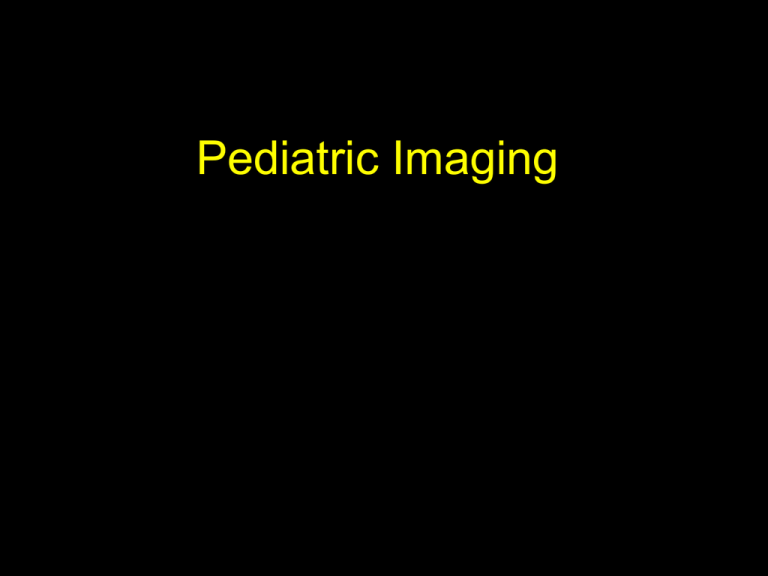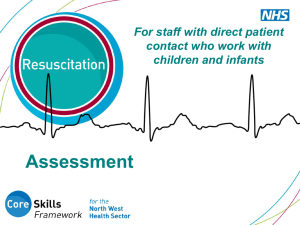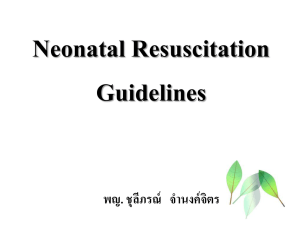Pediatric Imaging
advertisement

Pediatric Imaging What is pediatrics? • Branch of medicine dealing with medical care of infants, children, and adolescents • For our purposes- anyone under 18 years old • Some hospitals say under 21 years • Some say under 13, with 13-17 considered “adolescent” or “teen” Important! When you are at your clinical site: • Do not get signed off, do not work alone on any pediatric pt until you are in your 4th semester • You may work with a tech on any pedi case up to that point….. 2 main areas where working with Peds differs from adults: – Immobilization techniques – Communication skills Dealing with children • Children are not small adultsneed to be approached at their level! – Use age-appropriate language – at their eye level • If child old enough to comprehend, speak directly to child (Parent will listen and appreciate special attention given to child) • Maintain honesty! Atmosphere • Environment is everything! • Waiting room - child friendly – Music, books or videos • Imaging room also should be child friendly • Dim rooms frighten little kids! Use distraction techniques when working with children Ask about school, sports, siblings, pets, etc. Knowledge of their world builds rapport • Become familiar with popular cartoons, TV shows, music, sports figures, etc. Dealing with Parents Often two pts to deal with: child and parent Parents • Introduce yourself to parents • Give your title and your duties • Be prepared to answer questions from parents! Communicating with Parent • If child too young to understand, explain exam to parent • Use non-medical terminolgy • Keep it simple • Don’t assume English is spoken or understood! • Answer questions with complete honesty Parent Participation If parent willing to help, can be very useful – Immobilizing child – Comforting child – Frees up tech to leave room, focus on other aspects of exam – Presence reassures nothing unprofessional is occuring! Usually better if only one parent helps – More space – less confusion – Prevents divorce! • Provide shielding for parent Dealing with Agitated Parent • Escort to x-ray room – Avoid upsetting others in waiting room • Speak in a soothing voice • Listen to concerns without interruption • Provide explanation and comfort, especially re: radiation protection – Parents - tone of anger, urgency – usually fear and not aggression at you - After procedure, explain what may happen next Remain Calm!! • No matter what happens, keep smiling! Age Specific Needs Infant to 6 months Warmth, security, and nourishment – Do not distinguish among caregivers – Startled by loud stimuli – Comforted by pacifier and familiar objects 6 months to 2 years Fearful of pain, separation from parents Limitations in movement Require most assertive immobilization! Parental participation helpful But good immobilization techniques better than several adults in lead aprons trying to physically restrain 2 to 4 years Very curious- enjoy fantasy, games Cooperate readily if treated like a game Love praise Agitated and aggressive child will not respond to games or other distraction techniques 5 years Vary widely Confident children respond well and with advanced maturity Scared children will cling to parent and act much younger 6 to 8 years Ideal for inexperienced tech – Eager to please – Easy to communicate with – Very modest Preteens and adolescents Able to understand Worried about recovery Need clear explanation Sensitive pregnancy issues arise If possible, female tech should inquire about menstruation Outpatient Vs Inpatient Radiographing outpatient children is easier, less stressful than inpatient Pt not as sick But--- lengthy waiting time – frustration • Communicate cause of delay • Let parent vent: listen calmly and sincerely Outpatient vs. Inpatient cont’d • Inpatient is more stressful due to degree of illness – Child fearful - separation from parents, strange environment – Parents - juggling work, siblings at home, and worried! Immobilizing Pt. • Should never be traumatic, torturous event for child! • Never cause harm! • Good communication! Shielding And Immobilization Devices • Shielding should be used religiously! • Velcro compression band • Bookend • Sandbag Pigg-o-Stat Immobilization Cross-Table Lateral Chest X-Ray Why should grids should not be used on children? Immobilization AP Chest X-Ray Immobilization - Skull Film Immobilization Technique Using Blankets Papoose Special Concerns Regarding Pediatrics • Omphalocele congenital defect herniation covered in thin, membranous sac of peritoneum containing bowel and perhaps liver • Gastroschisis similar but herniation occurs lateral to umbilicus and bowel not covered by sac • Herniated bowel contents must be kept warm and moist! Epiglottitis • One of most dangerous causes of upper airway obstruction in children • Usually bacterial infection • Soft tissue neck films may be necessary • Do not move child’s head or neck! • Peak incidence between ages 3 - 6 • Support child in upright position Myelomeningocele • Protrusion of spinal cord and meninges (3 layers around CNS- dura mater, arachnoid mater, pia mater) through vertebra • Result of spina bifida (birth defect involving incomplete development of spinal cord or its coverings) • May cause varying degrees of paralysis • Higher up spine- worse symptoms • Can be recognized by fetal sono in 17/18 week Croup • Airway is infected and inflamed • Usually caused by flu virus • Peak incidence is 6 mos. - 3 yrs. • Usually requires chest film and soft tissue neck films • Narrowing of trachea will be present on film Osteogenesis Imperfecta • Bone malformation – Very brittle bones • Prone to spontaneous fractures • Must be handled with care! Osteogenesis Imperfecta cont’d Be aware of changes in technical factors! Generally cut mAs in half If possible, view prior films No universal definition of Child Abuse It includes: • Physical injury-suspected not accidental or through neglect • Sexual abuse • Deprivation of nutrition, care or affection Child Abuse cont’d • Suspected child abuse must be reported by law! • Report suspicious situations to radiologist or attending! • Treat parents non-judgmentally with respect and courtesy! – Innocent until proven guilty – Don’t jeopardize their relationship with health care providers Child Abuse cont’d At least 10% of children under 5 years old brought into ER with alleged accidents have actually suffered nonaccidental trauma! Forces needed to break a bone in an infant or young child are enormous Any fx in this age group indicates a major traumatic event, not just a fall from a low height Shaken infant syndrome Child is held around chest and violently shaken back and forth Causes extremities and head to flail back and forth in whiplash movement Shaken infant syndrome con’t • Intracranial injury occurs as result of severe angular acceleration, deceleration and direct impact as head strikes solid object • Chest is compressed resulting in rib fxs • Arms and legs move about in whiplash movement resulting in typical 'corner' or 'bucket-handle'fxs Corner fracture • Small piece of bone is avulsed due to shearing forces on fragile growth plate . often subtle• Fx.s are likelihood of detection directly related to quality of radiologic studies! Bucket Handle Fx. are suspect! Elbow Images for suspected abuse No babygrams! Typical exams – Ap, lateral skull – AP, lateral complete spine – AP both humeri – AP both radii and ulnae - AP pelvis - AP both femora - AP both tibfib - AP both feet -AP, lateral CXR for ribs Premature Infant • Requires use of mobile radiography • Extreme care in handling • Shielding! • Greatest danger – hypothermia – To reduce risk of hypothermia, examine infants in warmer or isolette when possible 8.6 ounces 2 types of Isolettes Open bed Enclosed With portholes (note: moveable overhead warmer) If premature infant must come to department for procedure– Increase room temperature 20 to 30 minutes before arrival of child – Prepare infant for procedure in isolette - keep removal from isolette brief – Use heating pads and heaters – heater must be at least 2 feet from infant – Warm large bags of IV solutions to serve as hot water bottles – Monitor infant’s temperature during procedure Radiographing Peds Slide 50 Chest: Newborn to 3 Years • Good inspiratory image required for accurate diagnosis • Place child in Pigg-O-Stat using appropriate sleeve size • Explain to parent child will probably cry, but helps to get exposure on inspiration Getting a deep breath Make exposure at end of inspiration – Wait for end of cry – child will gasp – Synchronize your breathing with child’s – Watch abdomen – extends on inspiration – Watch chest wall – - rise and fall of sternum - ribs outlined on inspiration Chest: 3 to 18 Years • Place pt in seated position • Child holds sides of stand and rests chin on top • For lateral – arms raised with head held between them – Assistance may be needed Hips • Diaper removed! • Check for rotation of pelvis- pain causes child to compensate position • Velcro band and strips used to immobilize lower limbs in position • Sandbags or assistance used to immobilize arms Hips • Both sides examined for comparison • Symmetric positioning critical • Shield! cont’d Skull • Velcro • Head clamp – Even on sleeping child – Alleviate anxiety by referring to clamp as “earmuffs” Unique Features Of Pediatric Pt. Growth plates Epiphyseal Fractures Salter-Harris types Type 1 - Directly through growth plate Type 2 - Through growth plate, into metaphysis Type 3 - Through growth plate, into epiphysis Type 4 - Through metaphysis, across growth plate, into epiphysis Type 5 - Crushing of all, or part of growth plate Type 4 Type 5 Limb: Newborn to 2 Years • Greatest challenge! • Requires modified “bunny” wrapping technique • Plexiglas and bookends used to immobilize limb of interest Limb: Preschoolers • Best examined seated in parent’s lap • If parent unable to assist, immobilize child as described for younger children Limb: School-Age • Typically managed in same manner as adults • Use good communication skills and explanations Special Pediatric Examinations Bone Age Evaluate degree of skeletal maturation • Determines skeletal age vs.chronological age • Concern if child’s development is well behind or well advanced of peers • Left hand and wrist • 1- to 2-year-olds often use AP left knee Aspirated Foreign Body • Aspirated (lodged in larynx or trachea) • Common 6 months to 3 years – AP/Lateral 8X10 soft tissue neck – PA chest taken on inspiration and expiration used to check if object lodged in bronchus Ingested Foreign Body Use 14X17 film if both chest and abdomen will fit (not considered “babygram”) If object is radiolucent, may require esophageal studies Scoliosis • Defined as “presence of one or more lateral-rotary curvatures of spine” • 6 feet SID • 14 X 36 cassette • Use breast shields on females • Why is it taken PA? – saves radiation exposure to breasts AP, Lateral Full Spine Luque Instrumentation CXR w/Central Venous Catheter Used to: Administer medication or fluids, obtain blood tests Directly obtain cardiovascular measurements such as the central venous pressure Ventricular-Peritoneal Shunt







